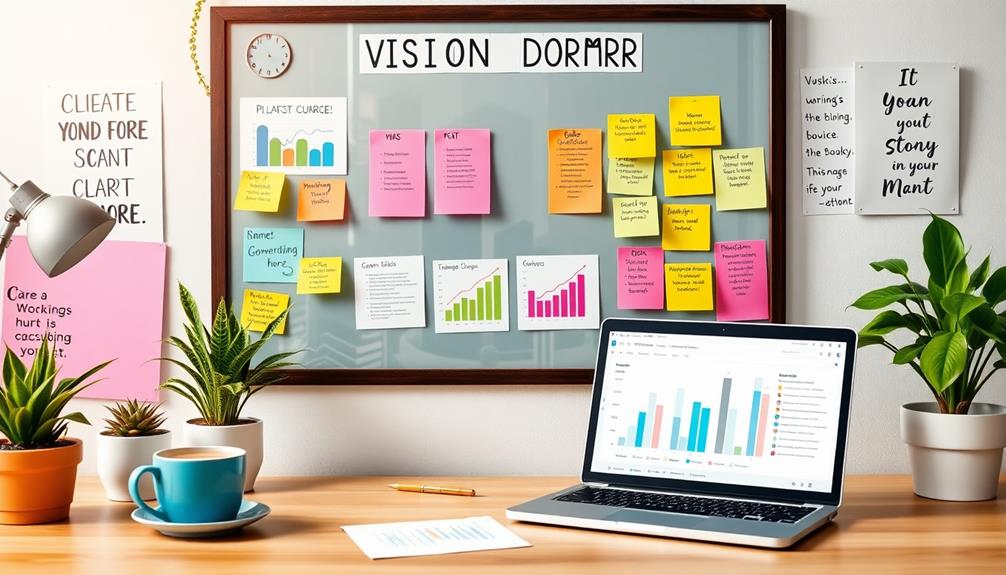Handling difficult clients confidently starts with clear communication and active listening. Recognize the specific behaviors, like indecisiveness or aggressiveness, to tailor your approach. Set clear expectations by outlining project parameters and timelines upfront. Practice empathy by validating their feelings and personalizing interactions. Use the Thomas-Kilmann model to choose appropriate conflict resolution strategies for each situation. Follow up consistently to show commitment and boost client satisfaction. When you focus on these techniques, you build trust and long-term relationships that enhance loyalty. Explore additional strategies to elevate your client interactions even further!
Key Takeaways
- Practice active listening to validate clients' feelings and foster a collaborative environment for effective conflict resolution.
- Set clear expectations by defining project parameters, timelines, and communication protocols to prevent misunderstandings.
- Use empathy by personalizing interactions and acknowledging specific client needs to strengthen relationships.
- Implement the Thomas-Kilmann Conflict Model to tailor conflict resolution strategies based on client behavior patterns.
- Maintain professionalism by documenting interactions and adhering to company policies to create a structured conflict management approach.
Understanding Customer Conflict

Understanding customer conflict is vital for any business aiming to maintain strong relationships and a positive reputation. Conflicts often arise when there's a disconnect between client expectations and their actual experiences. By understanding the problem, you can identify the root causes of complaints and address them effectively.
Effective conflict resolution enhances customer satisfaction and demonstrates your commitment to meeting client needs. Recognizing signs of dissatisfaction can be critical, as her telltale signs might parallel how clients express their frustrations.
Early resolution is key; it prevents issues from escalating and saves resources while strengthening customer relationships. When you engage in clear and empathetic communication, it fosters respect and builds trust. Your clients are more likely to feel valued when they know you're genuinely listening to their concerns.
Proactively managing customer conflicts not only safeguards overall satisfaction but also improves your public image. By addressing issues head-on, you show that you care about your clients' experiences and are willing to make things right.
Types of Difficult Clients

When working with clients, you'll encounter various difficult behaviors that can complicate your projects. Identifying these patterns is essential, as understanding their psychological motivations helps you tailor your approach.
By implementing effective engagement strategies, you can navigate these challenges and foster better relationships. Additionally, establishing healthy boundaries can be beneficial in managing client interactions and preventing burnout.
Recognizing the importance of open communication will also aid in resolving conflicts that may arise during the project.
Identifying Client Behavior Patterns
Identifying client behavior patterns is essential for managing difficult interactions effectively. Understanding the types of difficult clients you may encounter can help you tailor your approach.
For instance, indecisive clients often need extra guidance and clear options; they fear making mistakes, which can lead to project delays. Just as in supporting children through significant changes, open communication about their concerns can foster a more collaborative environment.
Micromanagers disrupt workflows by wanting control over every detail, stemming from a lack of trust in others' expertise.
Aggressors can escalate tensions with confrontational behavior, often driven by stress. Here, active listening and empathy are vital to de-escalate the situation. Similarly, encouragement of emotional expression through activities can be beneficial in these scenarios.
Ghost clients complicate communication; they're unresponsive and require proactive follow-up strategies to maintain engagement.
Understanding Psychological Motivations
Every client brings unique psychological motivations to the table, influencing their behavior and interactions. Understanding these psychological motivations is essential for effective conflict resolution.
For instance, indecisive clients often struggle with decision-making due to fear of making mistakes. This can lead to frequent changes and project delays, requiring your patience and guidance.
Micromanagers, on the other hand, display a lack of trust in your expertise. They insist on controlling every detail, which can hinder workflow and productivity.
Aggressors may confront you, driven by stress or feeling misunderstood. Active listening and empathy can help de-escalate their tensions.
Ghost clients are particularly challenging, as they become unresponsive, complicating communication efforts. You'll need proactive outreach strategies to re-engage them.
Strategies for Effective Engagement
Steering through the complexities of client relationships often involves engaging with difficult personalities. To handle difficult clients effectively, you need to adopt tailored strategies for each type. Here's a quick guide:
| Client Type | Key Characteristics | Effective Strategies |
|---|---|---|
| Indecisive Clients | Struggle with decision-making | Provide clear options and guidance |
| Entitled Clients | Expect preferential treatment | Set boundaries and manage expectations |
| Overly Demanding | Seek unrealistic outcomes | Establish realistic deliverables |
| Micromanagers | Lack trust in your expertise | Communicate openly and regularly |
| Impossible-to-Pleasing Clients | Quick to complain | Listen attentively and empathize |
Active Listening Techniques

Active listening is essential for effective communication and conflict resolution.
By using techniques like paraphrasing and asking open-ended questions, you can show clients that their concerns matter and build trust.
Let's explore how these methods can enhance your interactions and lead to better outcomes.
Importance of Active Listening
Listening intently is essential when maneuvering through conflicts, as it not only enhances understanding but also builds a meaningful connection between you and the speaker. Active listening plays a vital role in validating client frustrations, which is key to effective conflict resolution. When you fully concentrate on what your client is saying, you can acknowledge emotions and demonstrate that their concerns matter.
Using techniques like paraphrasing and summarizing helps reinforce your attentiveness and shows clients that you're genuinely engaged in the conversation. For example, saying, "I understand that this situation is frustrating for you," can make clients feel heard and valued.
Additionally, maintaining eye contact and utilizing nonverbal cues can greatly enhance your communication and signal that you're present in the moment.
Implementing active listening techniques, such as mirroring phrases or asking clarifying questions, fosters a more open dialogue. This not only helps to de-escalate tensions but also paves the way for more successful conflict resolution outcomes.
Techniques for Effective Listening
Effective communication hinges on your ability to engage fully during conversations, especially in conflict situations. Using active listening techniques can greatly enhance your interactions with difficult clients.
Start by maintaining eye contact; this signals your engagement and respect, prompting clients to open up about their concerns.
As they speak, make sure to avoid interruptions. Let them express their thoughts completely, as this shows respect for their perspective and fosters a more collaborative environment.
To demonstrate that you're truly listening, use verbal nods like "I understand" or "That makes sense." These affirmations reassure clients they're being heard, which can help diffuse tension.
Another effective technique is paraphrasing what the client has said. This not only confirms your comprehension but also validates their feelings.
When clients feel heard, it lays the groundwork for successful conflict resolution.
Building Trust Through Listening
Building rapport with clients hinges on how well you listen to them. Active listening isn't just about hearing words; it's about engaging fully. By maintaining eye contact, nodding, and using verbal affirmations, you can demonstrate your commitment to understanding their concerns.
| Technique | Purpose | Benefits |
|---|---|---|
| Active Listening | Show engagement | Builds trust |
| Paraphrasing | Confirm comprehension | Validates feelings |
| Acknowledge Feelings | Validate the client's experience | De-escalates tensions |
| Open-Ended Questions | Encourage detailed responses | Deepens understanding |
| Calm and Composed | Create a safe space | Enhances client comfort |
When you paraphrase your client's concerns, you're not just repeating them; you're showing that their feelings matter. Acknowledging their emotions can notably lower tensions. Additionally, open-ended questions invite clients to express themselves fully, allowing you to tailor your responses to their needs. Always endeavor to maintain a professional demeanor, remaining calm and composed. This approach fosters trust and encourages a more productive dialogue, ultimately leading to better conflict resolution.
Empathy and Personalization

Empathy and personalization are vital in customer service, as they can transform a frustrating interaction into a positive experience. When you practice empathy, you actively listen to your clients' concerns and validate their feelings. This approach notably reduces frustration and fosters emotional connections, which are essential for effective conflict resolution.
Personalization enhances this process by tailoring your responses to each individual. Using a client's name and referencing their unique situations shows that you genuinely care about their experience. Studies reveal that 70% of customers are more likely to remain loyal to brands that exhibit empathy during interactions.
By acknowledging clients' specific needs and emotions, you create stronger customer relationships. This empathy-driven communication fosters a culture of respect and understanding, allowing you to tailor solutions that address their individual concerns. Clients appreciate when their issues are recognized and addressed, leading to quicker resolutions and increased satisfaction.
Incorporating empathy and personalization into your customer service approach won't only improve your conflict resolution skills but also enhance your brand's reputation.
Problem-Solving Approaches

When addressing customer concerns, focusing on actionable solutions can make all the difference. To effectively resolve conflicts, you should prioritize problem-solving approaches that demonstrate your commitment to finding a solution.
Here are three key strategies to take into account:
- Active Listening: Engage with your customers by validating their feelings. Paraphrase their concerns to clarify misunderstandings, which fosters a cooperative dialogue and shows you care about their issues.
- Tailored Conflict Resolution: Utilize the Thomas-Kilmann Conflict Model to identify your conflict resolution style—whether competing, collaborating, compromising, avoiding, or accommodating. Adjust your approach based on the situation to better address customer concerns.
- Structured Follow-Up Process: After resolving an issue, implement a structured follow-up process. This not only enhances customer trust but also guarantees they feel valued and heard moving forward.
Offering alternatives, like discounts or additional services, can further alleviate dissatisfaction and reinforce your dedication to their satisfaction.
Maintaining Professionalism

Professionalism is essential in client interactions, as it not only safeguards your business's reputation but also boosts client satisfaction and retention. By maintaining professionalism, you guarantee that each client feels heard and valued, which is critical in conflict resolution.
| Professional Behavior | Impact on Client Relationship |
|---|---|
| Active listening | Builds trust and rapport |
| Solution-oriented communication | Helps resolve issues efficiently |
| Adherence to company policies | Maintains accountability |
| Documenting interactions | Provides a clear record for future reference |
When dealing with difficult clients, focus on solution-oriented communication. This approach prevents arguments and fosters mutual respect. Documenting interactions is essential for maintaining accountability, guaranteeing you have a clear record for future reference. By empowering yourself and your team to adhere to company policies, you create a structured environment that minimizes emotional strain and enhances team morale.
Setting Clear Expectations

Setting clear expectations is essential for smooth project execution.
You should define project parameters, communicate your availability, and establish realistic timelines right from the start.
Define Project Parameters
Defining project parameters is essential for a successful collaboration. When you set clear expectations from the outset, you create a framework that helps prevent misunderstandings and manage client concerns effectively.
Here are three key aspects to contemplate:
- Define Communication Protocols: Establish how and when you'll communicate. Specify response times and preferred channels to streamline interactions and avoid frustration.
- Establish Realistic Timelines: Clearly outline project deliverables, taking care to communicate any potential delays proactively. This transparency builds trust and guarantees everyone stays aligned.
- Set Boundaries on Project Changes: Define the limits regarding project changes and additional requests. By doing this, you can prevent scope creep and guarantee that all expectations are mutually understood.
Regularly revisiting these parameters throughout the engagement fosters ongoing alignment. It allows you to address any emerging client concerns promptly, guaranteeing that everyone remains on the same page.
In doing so, you not only manage expectations but also create a smoother, more productive working relationship. Remember, clarity is key to a successful project and a satisfied client.
Communicate Availability Clearly
Clear communication about your availability is essential for maintaining a productive working relationship. By outlining specific hours for communication, you guarantee clients know when to expect responses and updates. This helps set realistic expectations, which can prevent misunderstandings and reduce client frustration.
Utilizing multiple communication channels—like emails, phone calls, and messaging apps—gives clients options that accommodate their preferences. This flexibility can enhance their experience and improve overall satisfaction.
It's also important to document and share your availability in written contracts or agreements. This creates a reference point for both parties, promoting accountability.
Regularly updating clients on any changes to your availability reinforces transparency and nurtures trust in the client relationship. When clients feel informed, they're more likely to appreciate your efforts and remain engaged.
Establish Timelines and Deadlines
Establishing timelines and deadlines is essential for guaranteeing everyone involved understands the project's scope and expectations. By doing this, you clarify the work ahead and help prevent misunderstandings that could lead to conflicts.
Here are three key strategies to effectively establish timelines:
- Set Realistic Deadlines: When you establish timelines, make sure they're achievable. This fosters trust and shows your commitment to meeting client needs.
- Document Agreements: Always put agreed-upon timelines in writing, such as contracts or project briefs. This serves as a reference point, helping to prevent disputes and maintain professionalism in client interactions.
- Provide Regular Updates: Keep clients informed with regular updates on progress towards established deadlines. This not only reinforces transparency but also helps manage expectations, alleviating concerns.
Incorporating buffer periods for unexpected challenges is also vital. Clients should understand that flexibility may be necessary, which can further enhance trust.
Tools for Conflict Resolution

Effective tools for conflict resolution can make all the difference in how teams navigate disagreements. One essential resource is the Thomas-Kilmann Conflict Model, which outlines five distinct styles: Competing, Collaborating, Compromising, Avoiding, and Accommodating. By understanding these styles, you can choose the most effective approach for each situation, especially when dealing with challenging clients.
Conflict resolution training is another crucial tool. It equips you with skills like active listening and empathy, which are essential for managing professional interactions effectively. Utilizing structured training programs, such as those from Pollack Peacebuilding Systems, helps enhance organizational dynamics and prepares staff to handle conflicts with confidence.
Don't underestimate the power of de-escalation techniques. Techniques like mirroring customer phrases and using "I statements" can greatly reduce tensions in the moment.
Importance of Follow-Up

After resolving a conflict, the importance of follow-up can't be overstated. Engaging in follow-up interactions is essential for boosting customer satisfaction and fostering customer loyalty. When you reach out after a service issue, you demonstrate commitment, which can make customers feel valued.
Studies show that 90% of consumers feel more positive about a company that reaches out post-resolution.
Here are three key reasons to prioritize effective follow-ups:
- Address Concerns: Proactively resolve any lingering issues, reducing the likelihood of customer churn by up to 25%. This shows you care about their experience.
- Build Trust: Follow-ups reinforce trust. When customers see that you genuinely care about their feedback, they're more likely to remain loyal.
- Personalized Service: Documenting follow-up interactions provides valuable insights for future communications, ensuring a tailored approach that meets customer needs.
Building Long-Term Relationships

Building long-term relationships with clients is essential for sustainable business success. Effective conflict resolution plays a pivotal role in this process. When you handle conflicts properly, you can boost customer loyalty by up to 70%.
Proactively managing disputes shows your commitment to customer satisfaction, which fosters trust and encourages repeat business. Clients who feel that their concerns are addressed empathetically are more likely to share positive feedback.
In fact, 77% of customers would recommend a business after a positive service interaction. This type of advocacy enhances your brand reputation and attracts new clients.
Don't underestimate the power of follow-ups after resolving conflicts. Regular check-ins can lead to a 50% increase in customer retention rates, demonstrating your dedication to their needs.
Additionally, training your staff in conflict resolution techniques can greatly enhance your brand's standing, with 90% of consumers willing to pay more for a better customer experience.
Frequently Asked Questions
What Are the 3 C's for Resolving a Conflict?
To resolve a conflict, focus on the 3 C's: maintain calmness to control emotions, guarantee clarity in communication, and foster collaboration by working together to find solutions. These steps help create a more productive dialogue.
How Do You Handle Conflicts Challenges With the Clients?
When conflicts crop up, calmly connect. Listen actively, validate their feelings, and clarify expectations. With empathy and a structured plan, you'll tackle tensions effectively, turning challenges into cooperative conversations that strengthen your client relationships.
What Are the Four Basic Strategies for Resolving Conflicts?
To resolve conflicts effectively, you should practice active listening, demonstrate empathy, focus on problem-solving, and maintain clear communication. These strategies build trust and foster a collaborative environment, leading to positive outcomes for both parties.
What Are the Six Peaceful Methods of Resolving Conflicts?
You can resolve conflicts peacefully using six methods: negotiation, mediation, collaboration, compromise, arbitration, and avoidance. Each method suits different situations, helping you achieve desired outcomes while maintaining relationships and fostering understanding among parties involved.
Conclusion
In steering through the intricate dance of client relations, remember that even the most challenging individuals can be transformed into loyal partners with the right approach. By employing active listening, empathy, and clear communication, you can turn conflicts into opportunities for growth. Embrace the art of resolution, and don't shy away from follow-ups; they're the gentle nudge that reinforces commitment. Ultimately, fostering these connections can lead to enduring relationships that flourish beyond the initial hurdles.










